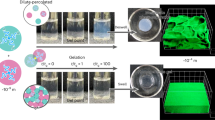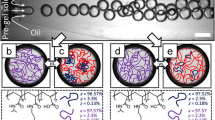Abstract.
The concept of network immunity, i.e., the robustness of the network connectivity after a random deletion of edges or vertices, has been investigated in biological or communication networks. We apply this concept to a self-assembling, physical network of microemulsion droplets connected by telechelic polymers, where more than one polymer can connect a pair of droplets. The gel phase of this system has higher immunity if it is more likely to survive (i.e., maintain a macroscopic, connected component) when some of the polymers are randomly degraded. We consider the distribution p(σ) of the number of polymers between a pair of droplets, and show that gel immunity decreases as the variance of p(σ) increases. Repulsive interactions between the polymers decrease the variance, while attractive interactions increase the variance, and may result in a bimodal p(σ).
Similar content being viewed by others
References
R. Albert, A.L. Barabási, Rev. Mod. Phys. 74, 47 (2002)
A. Wagner, Nat. Genet. 24, 355 (2000)
R. Albert, H. Jeong, A.L. Barabási, Nature 406, 378 (2000)
R. Cohen, R.S. Havlin, D. Ben-Avraham, Phys. Rev. Lett. 91, 247901 (2003)
E. Michel, J. Appell, F. Molino, J. Kieffer, G. Porte, J. Rheol. 45, 1465 (2001); M. Filali, M.J. Ouazzani, E. Michel, R. Aznar, G. Porte, J. Appel, J. Phys. Chem. B 105, 10528 (2001)
M. Adam, D. Lairez, M. Karpasas, M. Gottlieb, Macromolecules 30, 5920 (1997)
A. Zilman, J. Kieffer, F. Molino, G. Porte, S.A. Safran, Phys. Rev. Lett. 91, 015901 (2003)
Author information
Authors and Affiliations
Corresponding author
Rights and permissions
About this article
Cite this article
Hed, G., Safran, S. The immunity of polymer-microemulsion networks. Eur. Phys. J. E 19, 69–76 (2006). https://doi.org/10.1140/epje/e2006-00010-y
Received:
Published:
Issue Date:
DOI: https://doi.org/10.1140/epje/e2006-00010-y




